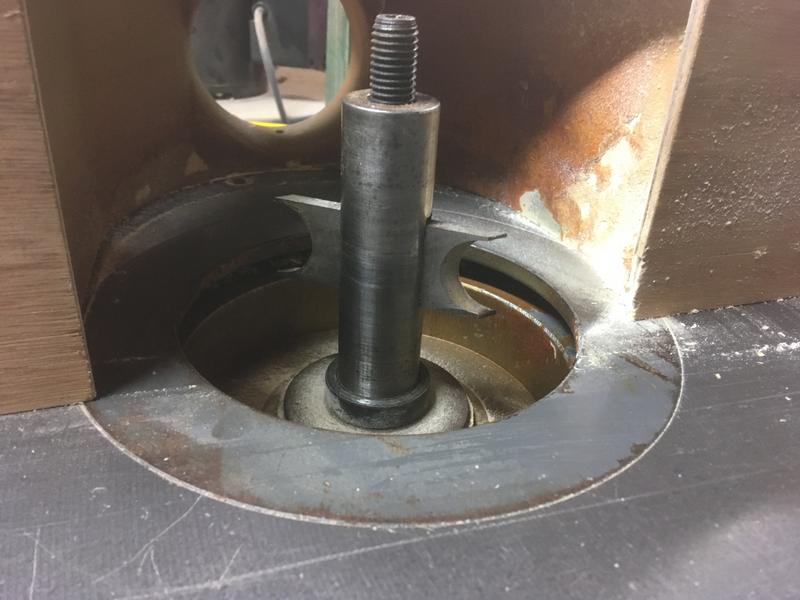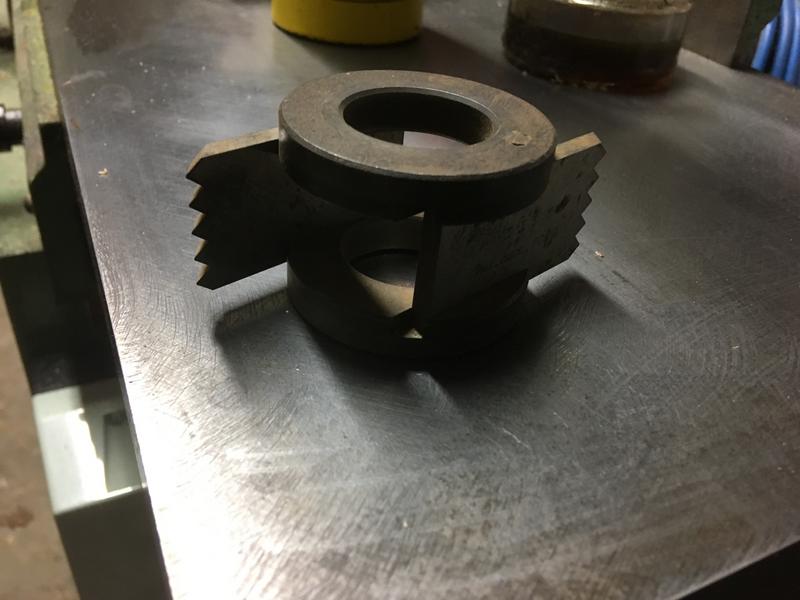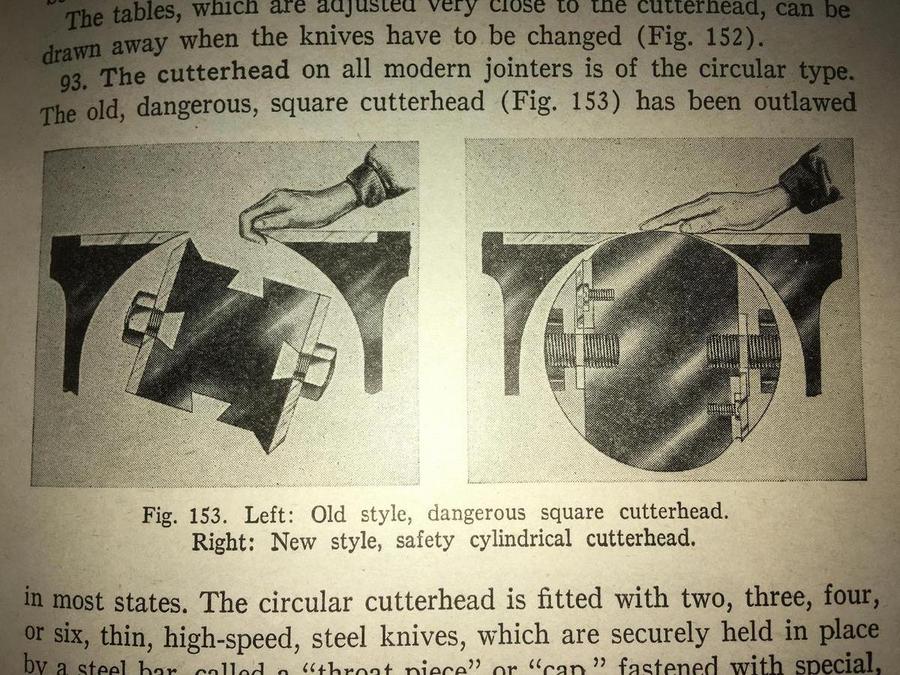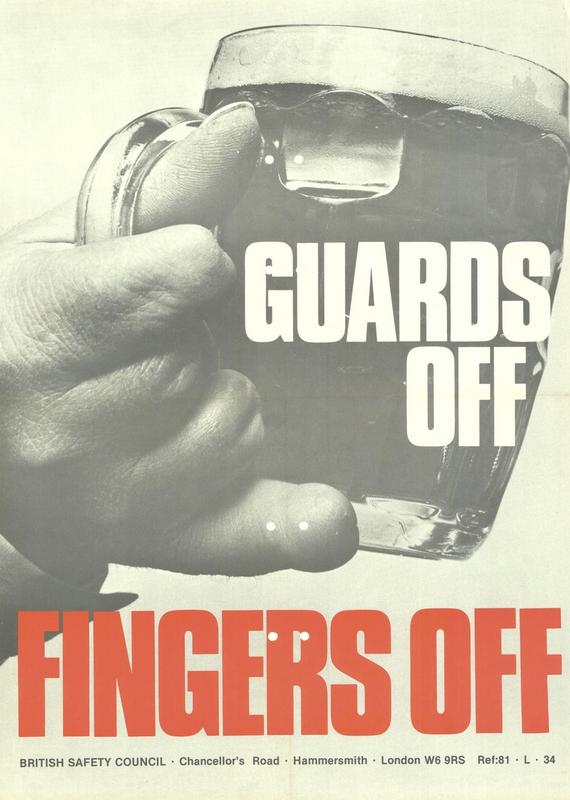You are using an out of date browser. It may not display this or other websites correctly.
You should upgrade or use an alternative browser.
You should upgrade or use an alternative browser.
Dado blades
- Thread starter Huddsgent
- Start date

Help Support UKworkshop.co.uk:
This site may earn a commission from merchant affiliate
links, including eBay, Amazon, and others.
Trevanion
Greatest Of All Time
It all depends on the size and length of the saw arbour, if it’s only designed to fit a single blade on a 30mm arbour that’s got about a 3mm protrusion you’ll never be able to fit dado blades. Another consideration to make is how much power does the saw have, I would say that you would need a 3HP machine minimum to run a dado stack effectively.
This thread may help you out, there is a small section on dado blades https://www.ukworkshop.co.uk/forums/a-guide-to-circular-saw-blades-t119811.html
https://www.ukworkshop.co.uk/forums/a-guide-to-circular-saw-blades-t119811.html
This thread may help you out, there is a small section on dado blades
Deadeye
Established Member
I have the 10" SIP. The arbor isn't long enough.
Hattori-Hanzo
Established Member
What size grooves are you looking to cut?
I wanted to fit a dado stack to our dimension saw but ran into the same problem the arbour being to short.
Don't know if it's true but I read its legislation, not allowed to sell a machine capable of stacking blades as burying the blade is illegal blah blah blah.
In the end I shimmed out the blade to turn it into a wobble saw which worked as I wanted but you are limited to how wide you can go. I wouldn't like to push it past 6mm but it depends on your saw, arbour and power, and how many grooves you have to cut.
It's okay for sporadic work but I wouldn't like to rely on it regularly.
I wanted to fit a dado stack to our dimension saw but ran into the same problem the arbour being to short.
Don't know if it's true but I read its legislation, not allowed to sell a machine capable of stacking blades as burying the blade is illegal blah blah blah.
In the end I shimmed out the blade to turn it into a wobble saw which worked as I wanted but you are limited to how wide you can go. I wouldn't like to push it past 6mm but it depends on your saw, arbour and power, and how many grooves you have to cut.
It's okay for sporadic work but I wouldn't like to rely on it regularly.
Trevanion
Greatest Of All Time
Hattori-Hanzo":72zbrtj0 said:Don't know if it's true but I read its legislation, not allowed to sell a machine capable of stacking blades as burying the blade is illegal blah blah blah.
I think so long as it’s sufficiently guarded using some form of groover is fine. I think the problem comes from meeting the stopping regulations where a blade should stop within 10 seconds (or was it 12? I really should know that :lol

£34.99 (£3.50 / count)
£39.99 (£4.00 / count)
VonHaus Chisel Set - 10pcs Woodworking Tools Set - Wood Carving Tools, Wood Chisel Sets with Sharpening Stone, Honing Guide and Storage Case
VonHaus UK

£24.99
Facemoon Reusable Masks,Safety Masks,Dual Filter Masks, Paint, Dust, Epoxy Resin, Construction, Welding, Sanding, Woodworking, Chemical Reusable Gas Masks
ShenZHEN CIRY MINGYANG LITIAN ELECTRONIC ECOMMERCE

£9.99 (£1.00 / count)
£14.45 (£1.44 / count)
JSP M632 FFP3moulded Disposable Dustmask (Box of 10) One Size suitable for Construction, DIY, Industrial, Sanding, dust protection 99 Percent particle filtration Conforms and Complies to EN 149
Amazon.co.uk

£16.99
£19.99
Respirator Mask,Safety Dust Face Cover,Dust Face Cover Paint Face Cover,Gas Mask With Filter,For Paint,Dust And Formaldehyde,Sanding,Polishing,Spraying And Other Work
ShenZHEN CIRY MINGYANG LITIAN ELECTRONIC ECOMMERCE

£49.91
£58.33
Mefape Mortise and Tenon Jig Tools for Woodworking Routers, Tenon Cutter, Manual Mortising Machine, Invisible Slotting Machine Jig Stand, 3-Axis Guide Rail for Adjust Trimming Length and Width
wangshijuntianjinhongyuegongyipin

£10.19 (£0.39 / count)
£11.99 (£0.46 / count)
Nicpro Carpenter Pencil with Sharpener, Mechanical Carpenter Pencils Set with 26 Refills, Case, Deep Hole Marker Construction Pencils Heavy Duty Woodworking Pencils for Architect (Black, Red)
NicproShop EU

£199.00
£360.17
Trend Portable Benchtop Router Table with Robust Construction for Workshop & Site Use, 240V, CRT/MK3
Amazon.co.uk

£10.10
£15.48
Portwest Browguard with Clear Visor, Size: One Size, Colour: Clear, PW91CLR
Amazon.co.uk
Hattori-Hanzo
Established Member
Trevanion":1nmwcud8 said:Hattori-Hanzo":1nmwcud8 said:Don't know if it's true but I read its legislation, not allowed to sell a machine capable of stacking blades as burying the blade is illegal blah blah blah.
I think so long as it’s sufficiently guarded using some form of groover is fine. I think the problem comes from meeting the stopping regulations where a blade should stop within 10 seconds (or was it 12? I really should know that :lol. I think so long as your machine has a DC brake capable of stopping a 5KG load within that time, without the locking nut coming loose, and that the machine is properly guarded for the task, it’s completely fine. Shimming saw blades into wobble saws however was outlawed back in the 70s! :lol:
Yeah all good points, also probably to do with having to remove the riving knife on most saws to run a stack, "they" seem to get into a right tizz over this though our American friends love running their saws without riving knives.
They outlawed those French head blocks we don't have a stack of in the corner :lol: but it's definitely a good thing they did!
Trevanion
Greatest Of All Time
Hattori-Hanzo":22w0ywai said:They outlawed those French head blocks we don't have a stack of in the corner :lol: but it's definitely a good thing they did!
French heads do have their place still if you’re working with seriously interlocked and curly timbers taking very light cuts, there’s no better piece of equipment for it since it takes a neutral scraping cut rather than a slicing cut so there’s absolutely no tear out. But the risk of kickback is tenfold compared to modern blocks since it’s technically “whacking” the timber with the face of the cutter each pass rather than cutting.
Just make sure to look down the road for the HSE inspector before installing them in the machine! :lol:
Inspector
Nyuck, Nyuck, Nyuck!
The "French block" is a new one to me, or the name is at least. Any of you have a picture of one so I can relate to it? Thanks
I wonder sometimes if flesh sensing technology ( SawStop ) had existed way back if the regulations governing dado blades would exist today?
Pete
I wonder sometimes if flesh sensing technology ( SawStop ) had existed way back if the regulations governing dado blades would exist today?
Pete
Trevanion
Greatest Of All Time
Inspector":232f6noh said:The "French block" is a new one to me, or the name is at least. Any of you have a picture of one so I can relate to it?
It’s less of a block and more of a spindle shaft with a slot in it to take cutters, It was the first primitive version of a spindle moulder cutter I believe from the late 1700s before they went onto cutter blocks and even nastier looking pieces of equipment.

Here’s a french spindle on a relatively modern Kity spindle moulder, the cutters are locked in place by a slot taken out of the bottom of the cutter so that it locks in place on the shaft, then the screw is tightened with a lock nut to keep it from coming loose. French cutters actually tended to be made of a softer carbon steel compared to any other cutters so that they could be filed easily without a grinder and a burr turned on the cutting edge just like a cabinet scraper.
I’ve got some slotted collar cutters somewhere which are even scarier looking if you want a photo of those! :lol:
Inspector":328g4inv said:The "French block" is a new one to me, or the name is at least. Any of you have a picture of one so I can relate to it? Thanks
Pete
If only one of the posters in this thread had had the foresight to build up a reference library of older wood machining practice!
I expect he'll be back with pictures quite soon...
Steve Maskery
Established Member
When I produced my comprehensive (ahem) treatise on tablesaw use on DVD nearly a decade ago now, I consulted the HSE, just to make sure I wasn't making any major boo-boos. They confirmed what I already knew.
1. Dado stacks are not illegal in the UK, neither to sell nor use.
2. What IS illegal is:
a) To use a TS in a commercial workshop that is not adequately guarded. Unfortunately the standard guard that comes with most TSs has to be removed as it is usually mounted on the riving knife. So some other suitable guarding has to be devised.
b) To use a TS in a commercial workshop that does not stop within 10 seconds of the power being cut. The increased mass of the stack c.f. an ordinary blade means that the momentum of the revolving blade keeps it moving longer than a normal blade. On a small light, saw, this is significant. On a bigger, more massive saw, the extra blade weight is of less significance.
I have an Xcalibur cabinet saw, sadly no longer available. It came with a short 30mm arbor and a long 5/8" arbor, so it will, and occasionally does, take a dado stack.
But it still stops in under 7 seconds, even at full stack, and I have devised a range of guards for use with different sawing operations, including dado stacks. I NEVER use my saw unguarded, whether the camera is on or not.
I'm not aware of any other saw available in the UK that will accept a dado stack, although I believe that one of the top-end Scheppach saws does take some sort of grooving blade (though I don't think it is a stack).
Dado stacks produce very clean cuts, but the setup time and faff is only really worthwhile for production runs. There are usually other methods, quicker to set up, that achieve the same end, and are more suitable in the home workshop for one-offs and small runs.
If you do use one and use it for rebates and cabinet backs, I highly recommend my rebate and groove fence. But then, I would, wouldn't I?
1. Dado stacks are not illegal in the UK, neither to sell nor use.
2. What IS illegal is:
a) To use a TS in a commercial workshop that is not adequately guarded. Unfortunately the standard guard that comes with most TSs has to be removed as it is usually mounted on the riving knife. So some other suitable guarding has to be devised.
b) To use a TS in a commercial workshop that does not stop within 10 seconds of the power being cut. The increased mass of the stack c.f. an ordinary blade means that the momentum of the revolving blade keeps it moving longer than a normal blade. On a small light, saw, this is significant. On a bigger, more massive saw, the extra blade weight is of less significance.
I have an Xcalibur cabinet saw, sadly no longer available. It came with a short 30mm arbor and a long 5/8" arbor, so it will, and occasionally does, take a dado stack.
But it still stops in under 7 seconds, even at full stack, and I have devised a range of guards for use with different sawing operations, including dado stacks. I NEVER use my saw unguarded, whether the camera is on or not.
I'm not aware of any other saw available in the UK that will accept a dado stack, although I believe that one of the top-end Scheppach saws does take some sort of grooving blade (though I don't think it is a stack).
Dado stacks produce very clean cuts, but the setup time and faff is only really worthwhile for production runs. There are usually other methods, quicker to set up, that achieve the same end, and are more suitable in the home workshop for one-offs and small runs.
If you do use one and use it for rebates and cabinet backs, I highly recommend my rebate and groove fence. But then, I would, wouldn't I?
Inspector
Nyuck, Nyuck, Nyuck!
Trevanion show me your worst. I have a strong stomach and a curiosity to match.
Steve the Xcaliber you have reminds me of my first table saw (still have it buried in a corner of the shop) that has interchangeable ends. They screw into the arbor and have a short taper after the thread, then the shoulder and thread for the blade nut. Much like a simplified milling machine arbor used in the bigger machines. I bought a 5/8" short, 5/8" long and a 1" short. Kind of wish I had bought the long 1" arbor at the time too for a pair of blades and spacer. The long arbors don't allow full tilt to 45º or they hit the throat plate. The saw is comfortable with a 10" dado stack. The SawStop that replaced it can only take an 8" dado.
Pete
Steve the Xcaliber you have reminds me of my first table saw (still have it buried in a corner of the shop) that has interchangeable ends. They screw into the arbor and have a short taper after the thread, then the shoulder and thread for the blade nut. Much like a simplified milling machine arbor used in the bigger machines. I bought a 5/8" short, 5/8" long and a 1" short. Kind of wish I had bought the long 1" arbor at the time too for a pair of blades and spacer. The long arbors don't allow full tilt to 45º or they hit the throat plate. The saw is comfortable with a 10" dado stack. The SawStop that replaced it can only take an 8" dado.
Pete
Steve Maskery
Established Member
Inspector":2nbnj221 said:The long arbors don't allow full tilt to 45º or they hit the throat plate. The saw is comfortable with a 10" dado stack. The SawStop that replaced it can only take an 8" dado.
Pete
I think you mean full tilt at full height
Indeed, and that is a weakness, though I think it has been only one occasion when that shortcoming has stopped me doing what I wanted.
Full tilt at a shallow cut is possible and is a good way of cutting V-grooves.
My stack is only 8" as well (Freud Safety Dado).
powertools
Established Member
I have a dado set for my radial arm saw and to be honest I havent used it for several years.
As Steve says the set up time is not worth it unless you are doing a massive amount of cuts.
I really dont think that any hobby woodworker needs one and there are better options for professional wodworkers.
As Steve says the set up time is not worth it unless you are doing a massive amount of cuts.
I really dont think that any hobby woodworker needs one and there are better options for professional wodworkers.
Inspector
Nyuck, Nyuck, Nyuck!
Steve I have a Freud 8" dado with anti-kickback teeth which I presume is similar. I have had the anti-kickback portions ground off by a local sharpening service because they limit the braking action of the SawStop. I'd rather have the blade stopped a tooth or two sooner if it came to that.
Powertools I don't find it taking a lot longer to set up a dado stack (even with having to change the brake) than to set up a router and it is a cuts a lot faster. Not as noisy either. It does depend on how large a project is and the type of work you want to accomplish. I would not bother with it if I was only going to make a small box or similar. Each tool in at our disposal has overlapping abilities and it is left to us to decide on which one we would rather use. Often getting the hand tools out can get the task done before setting up a machine. :wink:
Pete
Powertools I don't find it taking a lot longer to set up a dado stack (even with having to change the brake) than to set up a router and it is a cuts a lot faster. Not as noisy either. It does depend on how large a project is and the type of work you want to accomplish. I would not bother with it if I was only going to make a small box or similar. Each tool in at our disposal has overlapping abilities and it is left to us to decide on which one we would rather use. Often getting the hand tools out can get the task done before setting up a machine. :wink:
Pete
Steve Maskery
Established Member
Chippyjoe":3pr08lbg said:Steve,
I think Felder do a dado option on some of their saws that are available in the UK.
Mark.
Ah, OK. I'm not in that league!
Trevanion
Greatest Of All Time
Inspector":2wzv1cbp said:Trevanion show me your worst. I have a strong stomach and a curiosity to match.
OK

The literal principle of these is somebody's taken a couple of spindle spacers, put two grooves in each to accept a pair of 4mm cutters :lol:. They're quite versatile but absolutely lethal in the wrong hands! This pair has pins to index the knives and to keep them from flying out but quite a lot of this type relied on a friction fit, some of the top-end ones had screw adjusters and a serrated/threaded back knife to allow adjustment. I've seen some also that had a bearing incorporated into one of the collars which allowed it to follow a form nailed to a piece of timber to be cut. I think a name I've heard them being called also was "dumplings" but I cannot remember where I heard that.

I picked this up the other day, I'm sure you've seen one before but it's an 11" Wadkin Trencher. I've conferred with the local Wadkin expert ( :wink: ) who believes this may be actually off a tenoner due to the keyway rather than a radial arm saw or spindle, which makes sense for some jobs such as mass-producing door linings. I'm probably never going to use it so I might sell it on rather than hang it on the wall, but for the sake of what I paid for it, it would look pretty cool on the wall.

The one to rule them all, the square block. I don't have one so this picture I've lifted from google and a picture from Herman Hjorth's "Machine Woodworking" will have to suffice. These were the staple of all woodworking workshops of the early half of the 20th century and are what gave all machines with a spinning cutter block their fearsome finger-eating reputation. The massively unlimited cut meant that if you came into contact with the block you were dragged in at extreme speed and before you knew what happened you'd be missing a hand, this also, of course, translated into cutting timber as they had a reputation for extreme kickbacks. The shape of the block and the extreme projection of the knives meant that there was a massive amount of air displacement and sound pressure, which made them extremely loud and the draught coming from them comparable to an industrial air fan, which is why many older wood machinists (The ones left anyway) are near-deaf from no hearing protection and using some of the loudest equipment possible. They were outlawed in America by the 40s which should give some indication to how dangerous they are, I don't think Britain caught up with a outright ban until the 70s, but they were largely considered obsolete by the 50s.

AndyT":2wzv1cbp said:If only one of the posters in this thread had had the foresight to build up a reference library of older wood machining practice!
That reminds me! I recently bought a couple of new books that I need to add to the list
Similar threads
- Replies
- 14
- Views
- 793
- Replies
- 26
- Views
- 1K
























